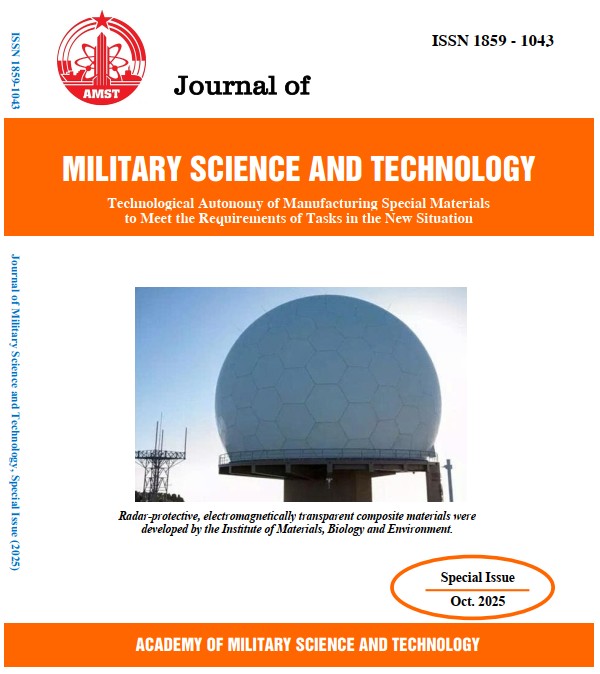Application potential of the IPFOS-Bacillus synbiotic product in military health protection
DOI:
https://doi.org/10.54939/1859-1043.j.mst.IMBE.2025.158-164Keywords:
Synbiotic; Immune; Digestion; IPFOS-Bacillus.Abstract
Prebiotics and probiotics are known to play beneficial roles in human nutrition and health. In this study, the effects of IPFOS-Bacillus synbiotic product, a combined prebiotic–probiotic formulation, were evaluated for digestive support and immune modulation in an animal model. Administration of IPFOS-Bacillus at doses of 37.2 mL/kg/day and 44.6 mL/kg/day significantly reduced diarrhea incidence and restored intestinal microflora balance (p < 0,05) in rats. Both doses also increased total spleen protein content (p < 0,05) and lymphocyte count in diarrheic rats. No pathological abnormalities were observed in the heart, liver, kidneys, lungs, spleen, or digestive system. These findings suggest that IPFOS-Bacillus has strong potential for development as a health protection product to be issued to soldiers.
References
[1]. Valle, M.C.P.R. et al., “Immune status, well-being and gut microbiota in military supplemented with synbiotic ice cream and submitted to field training: a randomised clinical trial”, British Journal of Nutrition, 126(12), pp. 1794–1808, (2021).
[2]. Bineid, M.M. et al., “The effect of probiotics, prebiotics and synbiotics on gut microbial community profile in overweight and obese Latin American and Caribbean populations: a systematic review of human trials”, Gut Microbiome, 6, p. e2, (2025).
[3]. Yadav, M. et al., “Synbiotics as potent functional food: recent updates on therapeutic potential and mechanistic insight”, J Food Sci Technol, 61(1), pp. 1–15, (2024).
[4]. Payne, J. et al., “The Potential of Bacillus Species as Probiotics in the Food Industry: A Review”, Foods, 13(15), (2024).
[5]. Mazkour, S., S.S. Shekarforoush, and S. Basiri, “The effects of supplementation of Bacillus subtilis and Bacillus coagulans spores on the intestinal microflora and growth performance in rat”, Iran J Microbiol, 11(3), pp. 260–266, (2019).
[6]. Jäger, R. et al., “Probiotic Bacillus coagulans GBI-30, 6086 Improves Protein Absorption and Utilization”, Probiotics and Antimicrobial Proteins, 10(4), pp. 611–615, (2018).
[7]. Flore, T.N., Z.N. François, and T.M. Félicité, “Immune system stimulation in rats by Lactobacillus sp. isolates from Raffia wine (Raphia vinifera)”, Cell Immunol, 260(2), pp. 63–65, (2010).
[8]. Tripathi, N., M. Zubair, and A. Sapra, “Method of Gram Staining”, in StatPearls, The Station, (2025).
[9]. Slaoui, M. and L. Fiette, “Histopathology procedures: from tissue sampling to histopathological evaluation”, in Drug Safety Evaluation: Methods and Protocols, Springer, pp. 69–82, (2010).
[10]. Kruger, N.J., “The Bradford method for protein quantitation”, The Protein Protocols Handbook, pp. 17–24, (2009).
[11]. Aziz, T. et al., “Elucidating the role of diet in maintaining gut health to reduce the risk of obesity, cardiovascular and other age-related inflammatory diseases: recent challenges and future recommendations”, Gut Microbes, 16(1), p. 2297864, (2024).
[12]. Oyetayo, V., “Performance of rats orogastrically dosed with faecal strains of Lactobacillus acidophilus and challenged with Escherichia coli”, African Journal of Biotechnology, 3(8), pp. 409–411, (2004).
[13]. Chen, Y.-H. et al., “Synbiotics Alleviate Hepatic Damage, Intestinal Injury and Muscular Beclin-1 Elevation in Rats after Chronic Ethanol Administration”, International Journal of Molecular Sciences, 22(22), p. 12547, (2021).







